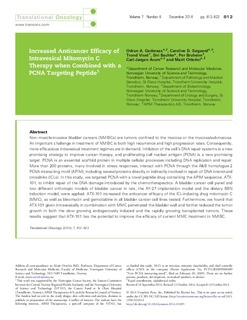| dc.contributor.author | Gederaas, Odrun Arna | |
| dc.contributor.author | Søgaard, Caroline Danielsen | |
| dc.contributor.author | Viset, Trond | |
| dc.contributor.author | Bachke, Siri | |
| dc.contributor.author | Bruheim, Per | |
| dc.contributor.author | Arum, Carl-Jørgen | |
| dc.contributor.author | Otterlei, Marit | |
| dc.date.accessioned | 2015-01-05T13:49:49Z | |
| dc.date.accessioned | 2016-04-27T14:12:01Z | |
| dc.date.available | 2015-01-05T13:49:49Z | |
| dc.date.available | 2016-04-27T14:12:01Z | |
| dc.date.issued | 2014 | |
| dc.identifier.citation | Translational Oncology 2014, 7(6):812-823 | nb_NO |
| dc.identifier.issn | 1936-5233 | |
| dc.identifier.uri | http://hdl.handle.net/11250/2387661 | |
| dc.description.abstract | Non–muscle-invasive bladder cancers (NMIBCs) are tumors confined to the mucosa or the mucosa/submucosa.
An important challenge in treatment of NMIBC is both high recurrence and high progression rates. Consequently,
more efficacious intravesical treatment regimes are in demand. Inhibition of the cell’s DNA repair systems is a new
promising strategy to improve cancer therapy, and proliferating cell nuclear antigen (PCNA) is a new promising
target. PCNA is an essential scaffold protein in multiple cellular processes including DNA replication and repair.
More than 200 proteins, many involved in stress responses, interact with PCNA through the AlkB homologue 2
PCNA-interacting motif (APIM), including several proteins directly or indirectly involved in repair of DNA interstrand
crosslinks (ICLs). In this study, we targeted PCNA with a novel peptide drug containing the APIM sequence, ATX-
101, to inhibit repair of the DNA damage introduced by the chemotherapeutics. A bladder cancer cell panel and
two different orthotopic models of bladder cancer in rats, the AY-27 implantation model and the dietary BBN
induction model, were applied. ATX-101 increased the anticancer efficacy of the ICL-inducing drug mitomycin C
(MMC), as well as bleomycin and gemcitabine in all bladder cancer cell lines tested. Furthermore, we found that
ATX-101 given intravesically in combination with MMC penetrated the bladder wall and further reduced the tumor
growth in both the slow growing endogenously induced and the rapidly growing transplanted tumors. These
results suggest that ATX-101 has the potential to improve the efficacy of current MMC treatment in NMIBC. | nb_NO |
| dc.language.iso | eng | nb_NO |
| dc.publisher | Elsevier | nb_NO |
| dc.rights | Navngivelse 3.0 Norge | * |
| dc.rights.uri | http://creativecommons.org/licenses/by/3.0/no/ | * |
| dc.title | Increased Anticancer Efficacy of Intravesical Mitomycin C Therapy when combined with a PCNA Targeting Peptide | nb_NO |
| dc.type | Journal article | nb_NO |
| dc.type | Peer reviewed | nb_NO |
| dc.date.updated | 2015-01-05T13:49:49Z | |
| dc.source.volume | 7 | nb_NO |
| dc.source.journal | Translational Oncology | nb_NO |
| dc.source.issue | 6 | nb_NO |
| dc.identifier.doi | 10.1016/j.tranon.2014.10.005 | |
| dc.identifier.cristin | 1190773 | |
| dc.description.localcode | © 2014 Neoplasia Press, Inc. Published by Elsevier Inc. This is an open access article under the CC BY-NC-ND license (http://creativecommons.org/licenses/by-nc-nd/3.0/). | nb_NO |

